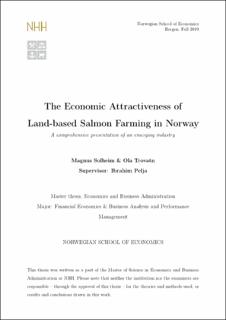The economic attractiveness of land-based salmon farming in Norway : a comprehensive presentation of an emerging industry
Master thesis
Permanent lenke
https://hdl.handle.net/11250/2646947Utgivelsesdato
2019Metadata
Vis full innførselSamlinger
- Master Thesis [4372]
Sammendrag
In this thesis we explore the economic attractiveness of land-based salmon farming in
Norway, an entirely new industry with the potential of revolutionising fish farming. We
will provide a comprehensive overview of the current status of the industry, as such
information simply does not exist. Further, we will examine trends for both land-based
and sea-based salmon farming in order to provide much needed insight on the possible
future of these industries.
Planned land-based facilities with a total production equal to 32.3% of world production
(2018), has been disclosed. As of such, our main focus is to investigate under which
circumstances land-based farming is economically attractive. This is a prerequisite for
understanding whether or not the industry can achieve the current expectations of success.
Despite massive interest of land-based farming there is a lack of both up-to-date and
robust estimates of its economic attractiveness. We remedy this by being the first to
examine the economic attractiveness avoiding unreliable estimates on cost components.
Instead, we use two entirely new approaches for this industry: 1) we estimate the implicit
maximum total cost per kg, and 2) we use the most up-to-date estimates and capture the
uncertainty in our assumptions with a Monte Carlo simulation.
Our principal results implies that the land-based farming industry is currently not proven
economically attractive. We find that the point of break-even is an implicit maximum
total cost per kg (HOG) of NOK 50.1 when using a 20 year modelling period and the
forward price. We also report that our modelled facility, with the same assumptions, has
a negative value of equity of NOK -53.6 million. The Monte Carlo simulation find a 47.8%
probability for positive net present value of equity.
However, small changes in assumptions may alter this conclusion. With recent
developments in regulation and industry sentiment making sea-based farming less
competitive, and the prediction that the performance/price ratio of land-based farming
will increase as a function of effort invested, it is likely to see a shift towards land-based
farming in the future.
Keywords – Land-based salmon farming, RAS, industry report, biological challenges
